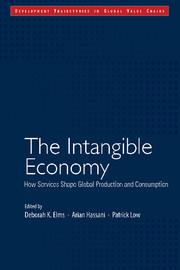Book contents
- Frontmatter
- Contents
- List of Figures, Tables and Boxes
- Acknowledgements
- 1 Introduction
- 2 Contextualizing Services in the World Economy
- 3 Services and Development: Priorities for Reform
- 4 Gainfully Linking into Global Value Chains: A Middle-Income Country's Perspective
- 5 Who Governs Global Value Chains?
- 6 Supply Chain Finance
- 7 Services and Economic Integration in ASEAN
- 8 Indian IT Firms: The Push for Innovation
- 9 Leveraging Business Process Outsourcing for Growth
- 10 Services in Global Value Chains and the Impact of Policy
- Contributors
- Index
- Development Trajectories in Global Value Chains
6 - Supply Chain Finance
Published online by Cambridge University Press: 19 October 2018
- Frontmatter
- Contents
- List of Figures, Tables and Boxes
- Acknowledgements
- 1 Introduction
- 2 Contextualizing Services in the World Economy
- 3 Services and Development: Priorities for Reform
- 4 Gainfully Linking into Global Value Chains: A Middle-Income Country's Perspective
- 5 Who Governs Global Value Chains?
- 6 Supply Chain Finance
- 7 Services and Economic Integration in ASEAN
- 8 Indian IT Firms: The Push for Innovation
- 9 Leveraging Business Process Outsourcing for Growth
- 10 Services in Global Value Chains and the Impact of Policy
- Contributors
- Index
- Development Trajectories in Global Value Chains
Summary
Introduction
The trade landscape has dramatically shifted over the past decades. Not only has global trade volume exploded, but the manner of production has also changed tremendously. The fragmentation of production among different jurisdictions has been greatly facilitated in recent years by a decline in transportation and communication costs, as well as technological advances. Global supply chains have become pervasive in many industries.
For efficient global supply chains, various services are important. Services, like information technology, research and development, human capital management, data analytics, inventory management and logistics, all have to be properly coordinated in an orchestra-like fashion. Financial services are keys to the operation of all supply chains. They can be likened to an invisible glue in global supply chain operations. Problems in financial services can bring global supply chain activity to a halt. For example, a study by the WTO shows that sudden financial constraints resulting from the global financial crisis contributed to the plunge in trade volumes during that period (Auboin and Engemann, 2013). Therefore, there is a need to look closely at financial services that underpin the smooth functioning of supply chains.
There is no globally-accepted definition of supply chain finance; however, this chapter considers two ways to understand supply chain finance and the various regulatory issues that can impact the availability of supply chain financing (SCF). First, SCF can be thought of as financing for the supply chain. Second, SCF can also refer to modalities associated with a specific banking instrument to connect buyers and suppliers in the supply chain.
The next section tackles the first meaning of SCF – the financing of supply chains – as something akin to structured trade financing. This section explains the credit origination process and various factors that financial institutions consider in financing different stages of the supply chain.
The third section of the chapter discusses the other meaning of supply chain finance – that is, modalities involving a bank financing instrument to connect suppliers and buyers in a supply chain relationship. Supply chain finance takes on various forms, including buyer-centric, supplier-centric, or even multiple buyer and seller SCF. However, this chapter discusses in detail only the most widely used of these forms, namely the SCF that is anchored to a major buyer.
- Type
- Chapter
- Information
- The Intangible EconomyHow Services Shape Global Production and Consumption, pp. 81 - 112Publisher: Cambridge University PressPrint publication year: 2017

